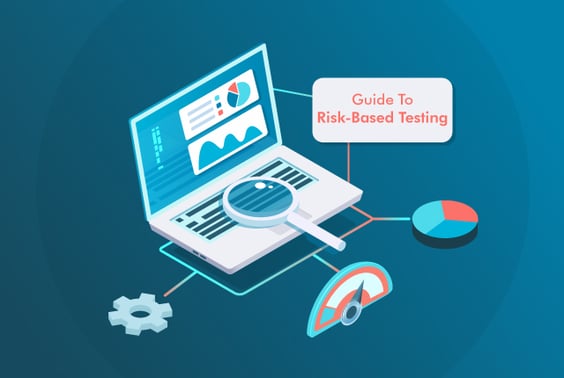
Modern applications are highly complex and require a lot of testing. A common complaint of QA and software developers is the lack of time given to test out every facet of a program. A risk-based testing method can address this issue. This method focuses on risks that the software is likely to encounter based on its complexity, intended use case, and design. Read on to learn more about risk-based testing and its importance to software development.
Types of Risk
Risk refers to a past, present, or future event that can negatively impact the success rate of a software project. There are two types of risks — product risks and project risks.
- Product Risks: These are risks associated with the software itself, particularly its likelihood to leave users and stakeholders unsatisfied. Examples of product risks include system compatibility issues, improperly coded loop control structure, delayed response times, unoptimized interface and system behavior, and subpar feature sets.
- Project Risks: Project risks refer to circumstances and other external factors that can hinder the software development process. These include project issues like delays and inaccurate cost estimates. These risks also cover organizational, political, supplier, and technical issues that QA developers may face during the development stage.
What Is Risk Testing?
Risk-based testing is a software-testing strategy where developers focus on product and project risks. It aims to prevent risks from affecting the software’s success, especially as the product transitions from the planning stage towards the development and production stages.
The primary purpose of this risk-based quality assurance method is to ensure that the final software is free from defects and gets released on schedule. It likewise aims to satisfy clients by making sure that the software delivers the expected features, quality, and price-to-performance ratio.
How Do You Determine Risk?
Risk is determined using a testing matrix. To get the exact risk rating of a particular event, the risk severity is multiplied by the likelihood of occurrence. A high rating would indicate that the event has a good chance of negatively affecting the success of the software project.
Moreover, three variables can help you determine how impactful risk factors are:
-
Criticality
Criticality refers to the level of impact a glitch or code error can have on the critical functionality of an application. For instance, a bug that leads to potential data loss or exposure will score high on the criticality scale.
-
Continuous Changes in Requirements
Frequent changes in requirements, also known as churn, can increase the risk of introducing errors in the software. When program areas have a high amount of churn, it means that they have undergone a lot of changes. These alterations make these areas more prone to glitches and errors compared to untouched parts of the software.
-
Complexity
There are simple and complicated program codes. Generally, the more complex a code is, the more likely it is to contain bugs. This is due to the high number of function paths these codes can take. One blocked or unresponsive path can lead to a system crash or malfunction.
The Process of Risk Management
Determining risks is crucial for implementing a successful risk-based testing approach. Here are the four main steps involved in risk management steps. Following each step carefully can help in mitigating risk effectively and efficiently.
-
Risk Identification
First, you need to identify the risks that require your limited time and manpower. There are several ways to pinpoint key risks. One way is through making an illustration or checklist like a cause and effect diagram, risk register spreadsheet, or risk breakdown chart. You can likewise conduct team brainstorms or interview domain professionals. This step helps in mitigating risk by ensuring that potential threats are recognized and resolved early on.
-
Risk Analysis
Risk analysis in software testing involves filtering risks according to their probable impact. Usually, more attention should be given to risks that are likely to jeopardize the software project. The testing matrix approach discussed earlier is a good way to assess and project risk impact levels. It allows for a more efficient testing process and reduces the likelihood of project delays or failures due to unforeseen risks.
-
Risk Response Planning
After determining which risks require the QA team’s attention, you need to plan your response. You can adopt a risk mitigation approach where the aim is to lessen the impact of the potential threat. Alternatively, you can set up a contingency plan where you think of a backup strategy should unpredictable risks occur. It ensures that the team is prepared to handle issues as they arise, leading to a more resilient project.
-
Risk Control and Monitoring
The last step in the risk-based testing process is risk control and monitoring. This is where you track down both residual and newly emerging risks and put them on your checklist. It’s also the stage where you manage risk impact by conducting audits, trend analysis, and performance measurements. This ongoing process ensures that risk management remains an active part of the project, allowing for timely response to new threats and minimizing the overall impact of risks on the project's deliverables.
Techniques for Risk-Based Software Testing
Several risk-based testing techniques facilitate efficient software development. Some of these include:
-
Lightweight Risk-Based Testing Techniques
Lightweight techniques give emphasis only to risk probability and potential effects. They consist of simple yet flexible qualitative schemes that apply to a wide range of domains. Furthermore, their straightforward nature makes them easy to integrate into any team’s testing process.
-
Collaboration and Communication
Regularly communicating progress to team members promotes transparency and fosters a shared understanding of the risk involved. Open communication among all stakeholders ensures that everyone is aligned with the objectives and strategies of risk management. Moreover, it facilitates timely decision-making and allows for necessary adjustments to the testing process.
-
Heavyweight Risk-Based Testing Techniques
Heavyweight techniques involve hazard analysis and cost exposure. Hazard analysis determines the dangers and pain points of every risk. Meanwhile, cost exposure projects the financial loss that a risk-related failure can cause during software production.
-
Pragmatic Risk Analysis and Management (PRAM)
PRAM is a lightweight risk-based testing technique that is usually employed during the early stages of software development. Risk analysis is used to determine options that lessen quality risks and influence product specification. Given the wide breadth of factors to consider, PRAM usually requires cross-functional team cooperation.
-
Systematic Software Testing (SST)
SST is a risk analysis approach that relies on requirement specifications as input to identify risk likelihood and impact. The generated output is then used to create a software test plan and formulate risk analysis and management strategies.
-
Product Risk Management (PRISMA)
PRISMA is a technique that focuses on monitoring and mitigating product risks. Provided product requirements and details are used as inputs to ensure adequate management coverage. Other important risks that are unspecified in the requirements are also tracked and analyzed.
-
Failure Mode and Effect Analysis (FMEA)
FMEA is one of the risk-based testing techniques that determine the cause and probable effects of risks. Risk prioritization is set based on severity, detection, and occurrence ratings. Given the complex nature and high documentation requirements of this technique, FMEA is often only used for conservative or high-risk software projects.
-
Fault Tree Analysis (FTA)
FTA analyzes both actual and potential risk-related failures. These failures then undergo a root cause assessment. Both the defects that cause the failure and the errors that cause the defects are identified. This comprehensive analysis method can significantly boost a project’s success rate.
-
Quality Function Deployment (QFD)
QFD identifies quality or potential risks that arise from the developer’s improper or insufficient interpretation of customer specifications. This technique ensures that the final program runs according to the general user’s expectations.
Benefits of Risk-Based Testing
Risk-based testing offers many advantages and can help you gain an edge over other software developers. Some of the benefits include:
-
Early Defect Detection
Concentrating on high-risk areas during the testing phase enhances the likelihood of identifying crucial flaws early in the development lifecycle. This facilitates prompt bug resolution, minimizing rework and related expenses. In addition, early detection of defects contributes to elevated software quality and heightened client satisfaction. Additionally, early defect detection helps to enhance software quality and boost customer satisfaction.
-
Improved Test Coverage
Through risk-based testing, testing efforts are aligned with the potential impact on end-users and business objectives, ensuring the optimal utilization of resources. This approach enables the formulation of comprehensive test strategies that prioritize critical functionality and high-risk areas. Consequently, test coverage is enhanced, minimizing the likelihood of overlooking significant defects.
-
Enhanced Test Efficiency
This testing approach optimizes the utilization of testing resources by focusing efforts on high-risk areas. By avoiding unnecessary testing of low-risk functionalities, time and effort are conserved, allowing testers to concentrate on areas of utmost importance. This leads to improved test efficiency, shorter testing cycles, and accelerated time-to-market.
-
Greater Focus on Customer Satisfaction
Risk-based testing focuses on monitoring and analyzing risk factors that affect customer experience. By catering to users’ needs and demands, developers are likely to develop a program that will not only receive positive reception but also offer practical and reliable features.
-
Improved Software Quality
Unchecked product and project risks can make the production software buggy at best and unresponsive at worst. Risk-based testing improves software quality since it aims to find and rectify these risks. More attention and resources are likewise given to essential software features, thus further enhancing software usability.
-
Faster Time To Market
Thousands of applications and other digital merchandise get released to the market daily. Risk-based testing can help you avoid falling behind your competitors. By using a risk-based quality assurance method, your QA team can fast-track the development, testing, and production stages. This will allow you to release your product quicker.
-
Proper Information on Test Coverage
Modern programs have several and sometimes complex lines of code. This makes it challenging to determine areas that have already been tested and those which need more attention. Since risk-based testing requires developers to document risk-related probabilities and impacts, it grants you access to proper information on test coverage and overall program status.
-
Better Optimization of Finances and QA Resources
Risk-based testing only prioritizes risks that can impact the success of your software project. Thus, your QA team can easily determine where to allocate project funds and manpower resources. Less time and money are spent on unessential variables and software aspects.
Rounding Up
Want an effective and efficient method to develop your program? Risk-based testing is a good option. It involves a streamlined process, and there are many techniques you can use depending on the type and complexity of the software being tested. Moreover, this risk-based quality assurance method offers several advantages, such as improved software quality and accurate test coverage data.
If you’re looking for a reputable QA outsourcing company that can help you implement risk-based testing, head to QASource. For over 22 years, we have been providing software testing services to clients from various industries. Contact us now to know more about our services.

